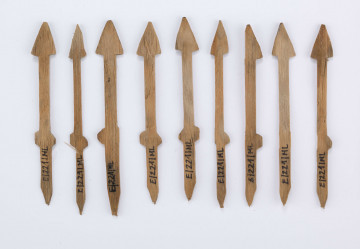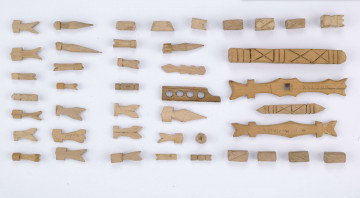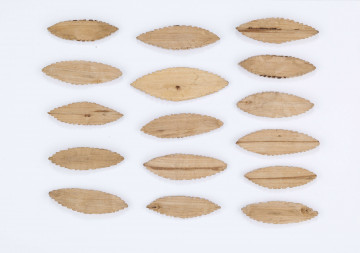
Game `Pick-up Sticks`
1901 — 1920
National Museum in Lublin
Part of the collection: Folk craft of the Lublin Region (19th/20th c.)
Although duty always had to come first, it was the nature of village children, like everyone else, to play. The only world they knew was their immediate environment, and it was from this that they drew their inspiration. By playing imitative games, they recreated situations familiar to them from everyday life: a girl would rock a doll, watching her mother putting her younger siblings to sleep, or learn the secrets of cooking by playing with miniature crockery, while boys would imagine long journeys into an unknown world by running through meadows and pastures on a stick horse or imitating the sounds of cars.
Children like animals. That is why figurines resembling animals were very popular at fairs and markets. One could choose from familiar forms such as cats, dogs, lambs, goats, hedgehogs or various birds: chickens, roosters, ducks, geese and even eagles, or more exotic ones such as elephants, camels, turtles and crocodiles. There were also figures of riders in lancer's uniforms. Some, thanks to holes for blowing, became whistles and increased their attractiveness. Most toys made of clay and covered with glaze were made by experienced potters while making large utility forms. Figurines made by themselves, such as this inconspicuous figurine of a cat made of marl, had a significant sentimental value.
Even though a folk toy constituted a kind of microcosm and was a child's companion and a witness to first joys and sorrows, was not subject to special care and its life was usually short. It was subject to more rapid deterioration and replacement determined by the child's age or interests. Although family traditions have, over time, given rise to rural folk toy-making centres in the Żywiec, Kielce, Myślenice, Leżajsk and Rzeszów areas, it lost its original function and began to be treated as a decorative object for some miraculous, for others wierd (see E/180/ML, E/187/ML, E/190/ML, E/217/ML, E/220/ML, E/544/ML, E/2146/ML, E/17030/ML).
Author / creator
Dimensions
cały obiekt: height: 7,5 cm, width: 4,5 cm
Object type
figurine
Technique
modelling
Material
clay
Creation time / dating
Creation / finding place
Owner
The National Museum in Lublin
Identification number
Location / status

1901 — 1920
National Museum in Lublin

1901 — 1920
National Museum in Lublin

1901 — 1920
National Museum in Lublin
DISCOVER this TOPIC
Castle Museum in Łańcut
DISCOVER this PATH
Educational path